Hermas villosa
Hermas villosa (L.) Thunb.
Family: Apiaceae
Common names: Tinderleaf (Eng.); tontelblaar (Afr.)
Introduction
The creamy green flowers of this fynbos shrublet usually light up the veld from late summer to late autumn. However its allure doesn't stop there. For the rest of the year its broad, glossy green and velvety grey leaves lend it a year-round interest.

Description
Description
Hermas villosa is a single- to multi-stemmed shrub of close to 1 m height. The leathery leaves are sessile to shortly petiolate and vary from oblong to elliptic. They are furthermore white-felted beneath and glabrous (hairless) above. Leafsizes are between 15 cm long and 6 cm wide. The leaf margins are toothed.
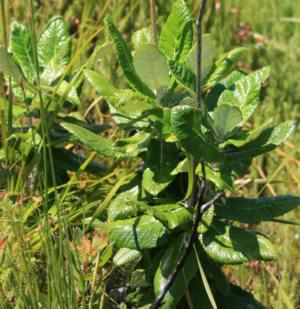
The cream-coloured globose flower clusters are about 4 cm across. Flowering is from December to May.
The fruits are suborbicular and winged. Harvest seed from late March to June.
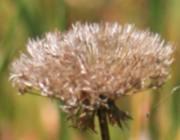
Conservation Status
Status
Hermas villosa has a status of Least Concern (LC) (Raimondo et al. (2009).
Distribution and habitat
Distribution description
This species is relatively common on the rocky sandstone slopes of the mountains from Cape Point to Hermanus.
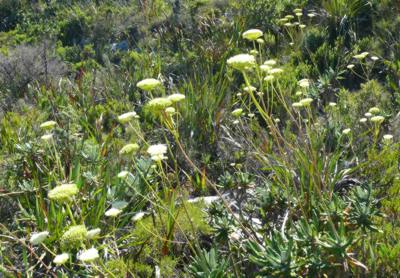
Derivation of name and historical aspects
History
The species was named by Carl Linnaeus. It is accepted that the origin of the genus name Hermas is not known. However, according to the early Roman church, Hermas was the seer of an apocalypse called The Shepherd. It is likely that this very same Hermas could have been the brother of Pope Pius I, circa 145 AD. There is the possibility that Linnaeus may somehow have learned of this person Hermas.
The specific epithet villosa means hairy and refers to the white-hairy underside of the leaves.
There are 7 species in the genus and they all occur in the fynbos biome.
Ecology
Ecology
Various insects have been noticed visiting the tinderleaf and anyone of these could possibly play a role in pollination.
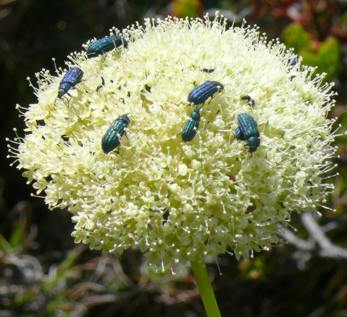
Uses
Use
The tinderleaf was used medicinally to dress wounds. The woolly hairs were scraped from the leaves, left to dry and then applied to the wound.They were also used in tinder boxes. This species is rarely grown in gardens. It, however, shows a lot of potential to be a stunning landscaping subject.
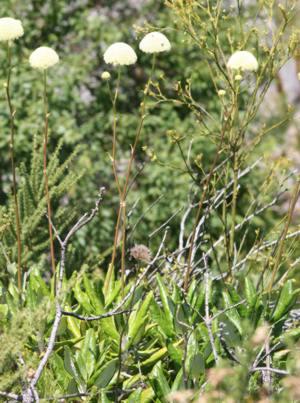
Growing Hermas villosa
Grow
This species is best grown from seed. To date vegetative techniques haven't been very successful.
Sow the seed during autumn or winter in a well-draining medium. Level the medium and then sow the light seeds evenly, water gently and cover with a thin layer of sand or bark. Place in a sunny position. The seed will germinate within two to three weeks.
Prick seedlings out from the trays as soon as they are large enough to handle. Place the potted seedlings in a sheltered position, like a shade net, and gradually start introducing the plants to full sun.
In its natural environment the tontelblaar is found to grow with a variety of fynbos species including Erica spumosa, E. coccinea, E. lutea, E. sitiens, Nivenia stokoei, Agapanthus africanus subsp. africanus, Aristea capitata, Watsonia tabularis, Crassula coccinea, Pelargonium cucullatum, Protea cynaroides, Leucadendron spissifolium, L. xanthoconus, L. laureolum and L. gandogeri.
It should also perform well with most of the other larger fynbos groups such as the Cape reeds (restios), proteas, ericas and buchus.
Hermas villosa is a resprouter which in nature receives a natural trim during a fire. It will therefore become lanky after a while. Cut it back in winter to ensure the plant maintains a bushy habit and neat appearance.
References
- Bean, A. & Johns, A. 2005. Stellenbosch to Hermanus. South African Wild Flower Guide 5. Botanical Society of South Africa, Cape Town.
- Manning, J. 2007. Field guide to ynbos. Struik, Cape Town.
- Goldblatt, P. & Manning, J. 2000. Cape Plants. A conspectus of the Cape flora of South Africa. Strelitzia 9. National Botanical Institute, Pretoria & Missouri Botanical Garden, Missouri.
- Manning, J. & Goldblatt, P. 1996. West Coast. South African Wild Flower Guide 6. Botanical Society of South Africa, Cape Town.
- Mustart, P. , Cowling, R. & Albertyn, J. 1997. Southern Overberg. South African Wild Flower Guide 8. Botanical Society of South Africa, Cape Town.
- Raimondo, D.,Von Staden, L., Foden, W., Victor, J.E., Helme, N.A., Turner, R.C., Kamundi, D.A. & Manyama, P.A. (eds). Red List of South African plants 2009. Strelitzia 25. South African National Biodiversity Institute, Pretoria.
- Stearn, W. 2002. Stearn's dictionary of plant names for gardeners. Timber Press, Portland, Oregon.
Credits
Roger Oliver
Kirstenbosch National Botanical Garden
March 2013
Plant Attributes:
Plant Type: Perennial, Shrub
SA Distribution: Western Cape
Soil type: Sandy, Loam
Flowering season: Late Summer, Autumn
PH: Acid, Neutral
Flower colour: Cream
Aspect: Full Sun
Gardening skill: Easy
Special Features:
Horticultural zones







Rate this article
Article well written and informative
Rate this plant
Is this an interesting plant?
Login to add your Comment
Back to topNot registered yet? Click here to register.